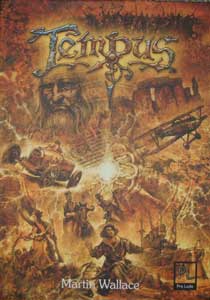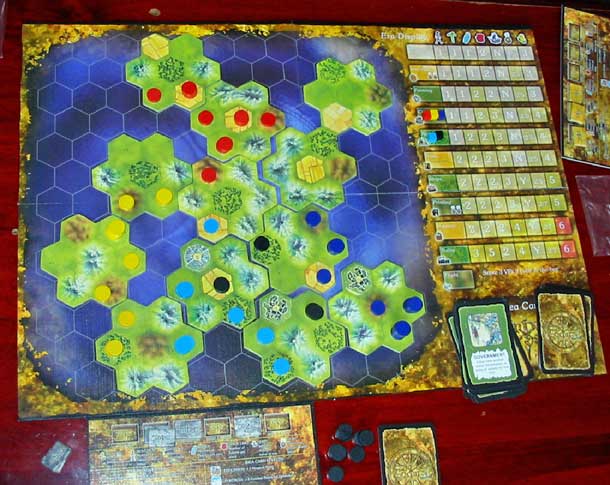Pevans
TempusReviewed by Pevans |
 Tempus has had a rocky start. Designed by Martin Wallace and published in the US (by Café Games) and Europe (by Pro Ludo and others), the game was due to appear at Spiel ’05. Production problems delayed things and Tempus didn’t make it. The game finally arrived on the shelves in mid-2006 with little fanfare. It was on show at last year’s Spiel, but was rather overshadowed by all the brand new games. Which is a shame, as a civilization-development game from Martin Wallace has to be worth more than just a look.
Tempus has had a rocky start. Designed by Martin Wallace and published in the US (by Café Games) and Europe (by Pro Ludo and others), the game was due to appear at Spiel ’05. Production problems delayed things and Tempus didn’t make it. The game finally arrived on the shelves in mid-2006 with little fanfare. It was on show at last year’s Spiel, but was rather overshadowed by all the brand new games. Which is a shame, as a civilization-development game from Martin Wallace has to be worth more than just a look.
My copy of Tempus is the (English language) European game, but the only difference from the US version, as far as I know, is the artwork. A blue square makes up most of the board and is overprinted with a hexagonal grid. Players place tiles onto this area to construct the island of Tempus with its various terrains. The number of tiles depends on how many are playing, as space is a significant factor. Players then set up a starting position of three wooden discs in their colour. The aim is to have the largest nation – in terms of cities and territory – at the end of the game’s ten turns (eras).
The other section of the board is a table showing Progress through the eras (game turns), from writing to flight. Each row shows the strength of players’ actions that turn – and how many actions they can take. As you’d expect, players can do more as the game goes on. To start with, it’s three actions each turn, taken one at a time round the table until everybody’s done. This rises to six actions a turn by the end of the game. To keep track of this, players each have a set of rectangular chips. They start the turn with the right number and place one on an action space on their board before taking the action.
Five actions are available to players each time. The first is move. Given that territory is a big factor in winning the game, it’s clearly important to move your pieces and gain more land. Initially, though, a move action is just one piece one space. Moving pieces around is thus time-consuming and laborious. Interestingly, players can use a whole move action to move a piece across an inland stretch of water. So it can be advantageous to make these at the beginning – provided you can use them later. After a few eras, players are able to move pieces from coast to coast around the island in the same way (they’ve discovered how to build ships). The number of pieces you can move in one action and how far they move both increase through the eras.
The second action is wonderfully described as “have babies.” Players take the action to place an extra piece in a grassland area where they already have a piece (or several). This is another important action in enabling players to expand their holdings. Through the eras players are able to add more than one ‘baby’ at a time, provided they have enough room. This is not just a question of having enough grassland areas – though grasslands are clearly important for expanding your nation. Players are also limited in the number of pieces they can have in one space. If you’re already at the limit, you can’t add a ‘baby’.
The third action is “build cities.” Players use this action to convert a stack of pieces into a city of the same value – provided the space isn’t a mountain or next to an existing city. Each player has their own set of hexagonal city tiles, each containing the same values. Clearly you want to build the more valuable cities, but this means getting enough pieces together. And, as we’ve already seen, the number of pieces in a space is limited. Again, this gets bigger as the game goes on, allowing players to build their biggest cities by the end. You still have to get the pieces into the same space, though.
Because players ‘make babies’ in grasslands, these are the easiest places to build cities. Do this too often, though, and you run out of places to add more pieces – and if everybody does it, the remaining grasslands become very valuable. As cities can’t be placed next to each other, players need to think carefully about where they position them. It’s all too easy to build a city in a place that stops you building more. Or even making the mistake of stacking up pieces next to a city, where you simply can’t build another one. Of course, if two players start building stacks next to each other, the first one completes their city and the other one can’t. It’s a useful tactic.
The next action is drawing Idea cards. Initially, players can draw two cards in an action and may keep a hand of up to five. In later eras players can draw more cards and hold a bigger hand. The cards give players all sorts of additional options: stack an extra piece in a space, move an extra piece, take two actions in a row and so on. Each card has one type of terrain as its background, which is a second way of using them, as we’ll see later. They can be played at any time, including in the middle of an action, and there’s no limit to the number you may play in a single action.
I should mention one rather powerful Idea card: Religion. This allows the player to convert a neighbouring piece to their colour and move it onto their own stack. As cards can be played at any time in an action, this can be used just before making an attack, changing the odds completely. The cards can be very powerful, but which cards you get depends on chance. It thus makes more sense to trim your tactics to the cards you have than settle on a strategy and hope to draw the cards to help this.
The final action is ‘Start a fight.” A fight is between the pieces in one space and the pieces or city in an adjacent space. It’s very simple: the bigger stack or value wins (the defender wins ties). However, either player can play cards to add to their strength. Some cards’ ability is additional attack or defence, but cards can also add to the strength if their background matches the terrain being fought over. In the case of a city, the defending player chooses the terrain for the battle, which gives them an advantage. If the attacker wins, the defender’s pieces (or city) are removed and the attacker can move in. If the attacker loses, they lose one piece.
This makes attacks attractive, but it can take a while to build up the forces, giving your target time to respond. There’s also a rule that a player with pieces in only three spaces (or fewer), can’t be attacked. Cities don’t count for this, so keeping your nation small is a useful defensive tactic. For this to work well, you need to keep on building cities. In turn, this means having the space and pieces to do this.

Once all players have used up their actions (and there is an advantage in being the last player to take an action), the era ends. All players are assessed for ‘Progress points.’ These are 1 per city plus the number of pieces in terrain that matches the background for the next era. Players can also play cards to add to their Progress points – either because that’s what the card does or because they match the terrain (or both). The player(s) with the most points advance to the next era, while the rest remain on the current one. This does not lengthen the game, as anyone who’s behind catches up at the end of the era, before counting Progress points, but does give players a slight advantage. Being in the next era usually means you can do something more than the other players: move an extra piece, take an extra action and so on. Two eras give a specific bonus in the form of extra Idea cards. And, at the end of the game, the players who advance get a 3 point bonus to their victory points.
While gaining the early advance to the next era can be useful, my experience suggests that players don’t need this every turn. Certain eras offer a particular advantage – such as number 4, ‘Cities’, which gives an extra action and increases the stacking limit. Whether you try to gain this will depend on how valuable it is to what you want to do in the next turn and how easy it is for you to win it. I reckon it’s unlikely to be worth spending a whole turn jockeying for position at the cost of improving your strategic position.
The game ends after assessing Progress at the end of the tenth era. Players score the value of the cities they have on the board, one point for each space (except mountains) they have pieces in and a three point bonus if they’ve advanced to ‘Flight’. There are a couple of tie-breakers if required.
Tempus is a fascinating and subtle game. I’m still learning more about it every time I play. At the same time, it’s a relatively simple game – the rules only take up 7 pages. The complexity is in getting the best out of the terrain, the cards and the opportunities offered by other players. The key to the game seems to be being able to control plenty of territory (though I may change my mind after my next game!). This gives you room to build cities and the space you need to produce more pieces. However, it does make you vulnerable to attack. Losing the odd space doesn’t make much difference, but losing several will do. Tempus gets 8/10 on my highly subjective scale.
Tempus was designed by Martin Wallace and is published by Café Games (in the US), Pro Ludo (in Germany), PS Games (in Holland), Raven Distribution (in Italy) and Editions Ubik (in France). It is a strategy board game for 3-5 players aged 14+ and takes 1-2 hours to play (I reckon at least 30 minutes per player).
This review was first published in TWJO 74, April 2007. A version was also published in Flagship 123, November 2007.